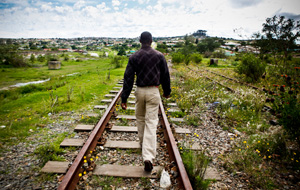The World Journalism Project
Department of Newspaper and Online Journalism
The S.I. Newhouse School of Public Communications

About Grahamstown
A Syracuse visitor would feel right at home in Grahamstown, whose economic heart is a college (the 6,000-student Rhodes University) and whose soul is its diverse people of good nature who enjoy a party (the summer National Arts Festival is the country’s largest such celebration).
Grahamstown — the City of Saints — is well-known for its dozens of churches (about 50) and many clocks (though the similarities to Syracuse end downtown, where there’s nothing to rival Armory Square’s 24-second shot clock).
Grahamstown — population 125,000 — is located 80 miles inland from Port Elizabeth on the Eastern Cape. It was founded about a dozen years before Syracuse, in 1812, by Lt. Col. John Graham to serve as a British military outpost. On April 22, 1819, Xhosa leader Makana launched an attack against Graham’s forces, but he failed and was captured and imprisoned. He later drowned during an escape attempt. (Grahamstown is located in Makana Municipality). Recently, local government began considering plans to change the name to iRhini (“the place of reeds”).
Syracuse wins the battle of newspapers: The Grocott’s Mail in Grahamstown dates to 1870, eclipsed by four decades by our paper, The Post-Standard (1829).
Our reporting team spent most of its time in the township area, which is home to the city’s black residents (77% of the total population). Its residences of mud or tin emphasized what we learned in our research: You’ll find one of the world’s largest gaps between the rich and poor here in South Africa. On the other side of town: Nice homes behind high walls topped with barbed wire. Take a walk here, and about seven of every 10 people you pass will be out of work.
The private sector trumps the public here: a local security firm, Hi-Tec, is the “law.” The local police are usually second on the crime scene. And private secondary schools are everywhere. According to the business and market risk analysis company Whythawk, the cost of a private school education for grades 1-12 ranges between $1,150-$6,900 per year, achievable only for a select group.
During our visit to the Eluxolweni Shelter for boys in the township, we were treated to a traditional African gumboot dance by three residents. If you’ve never seen this, it’s worth a watch.
And finally: a couple of unusual things:
— A really old fish fossil was found in the area recently (try 360 million years old).
— Grahamstown is said to have “the tallest toilet in the world” — an abandoned chimney — but we did not have the opportunity to investigate. Next time.